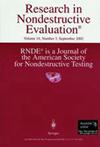利用高压灭菌器内部的超声波检测系统和机器学习来量化复合材料在固化过程中的孔隙率
IF 1.6
4区 材料科学
Q3 MATERIALS SCIENCE, CHARACTERIZATION & TESTING
引用次数: 0
摘要
摘要复合材料以其高刚度、高强重比和抗疲劳性能在航空航天领域得到越来越多的应用。然而,复合材料的缺陷可能在固化过程中出现(例如孔隙,分层,纤维波纹),并且目前的技术只允许固化后评估(例如显微镜,超声波检查)。开发了一种用于高压灭菌器的高温超声扫描系统,该系统可以检测复合材料在固化过程中的孔隙率。这项研究的重点是实现机器学习技术,以帮助生成一个可以量化孔隙度的模型,以及之前已经证明的检测和定位。2、762 mm × 305 mm (30 in。×12 .)复合面板与[0/45/90/-45]4s铺层和不同区域的高压和低压,由于其锥形几何形状接触的一个扁平的金属板。第一次实验使用厚(12.7 mm)的包膜板,第二次实验使用薄(3.2 mm)的包膜板。实验过程中,在扫描区域(406 mm × 13 mm)内记录并存储超声振幅数据。测量或预测了其他变量,包括温度、高压灭菌器压力、层数、复合面板表面相对于传感器的斜率、粘度和玻璃化转变温度。将预处理后的数据输入到MATLAB中的Regression Learner Application中Ⓡ,Footnote1,机器学习算法选择有理二次高斯过程回归(有理二次高斯过程回归)。然后在更大的数据集上训练该模型,使其更健壮,并能够使用函数标注进行预测。结果是一种机器学习算法,可以根据测量的振幅响应可靠地量化复合材料面板在固化过程中的孔隙率,并生成直观可视化的图像。该工具可以通过更多的实验进行进一步的训练,并有可能用于在高压灭菌器中固化复合材料组分的实时孔隙率检测和定量。该技术的实际应用是实时动态控制加工参数(例如高压灭菌器压力)的潜力,以将层压板内的孔隙率降低到可接受的限度(例如体积比为2%)。关键词:缺陷检测、过程检测、机器学习(ML)、孔隙率、过程监测、超声检测(UT)致谢作者要感谢Hoa Luong和Sean Britton在实验设置和数据收集方面的贡献。本出版物中报道的研究由美国国家航空航天局(NASA)的航空研究任务理事会(ARMD)提供资金支持。披露声明作者未报告潜在的利益冲突。明确提到特定的供应商和制造商名称只是为了准确地描述本研究中使用的硬件和软件。使用供应商和制造商名称并不意味着美国政府的认可,也不意味着指定的设备和软件程序是最好的。本研究得到了兰利研究中心的支持。本文章由计算机程序翻译,如有差异,请以英文原文为准。
Utilizing an Ultrasonic Inspection System Operating Inside an Autoclave and Machine Learning to Quantify Porosity within Composites During Cure
ABSTRACTComposite materials are increasingly being utilized in aerospace applications for their high stiffness and strength to weight ratios and fatigue resistance. However, defects in the composite may arise during cure (e.g. porosity, delamination, fiber waviness), and current technology only allows for post-cure evaluation (e.g. microscopy, ultrasonic inspection). A high-temperature ultrasonic scanning system was developed for deployment in an autoclave, which can detect porosity in composites during the cure process. This study focused on the implementation of machine learning techniques to help generate a model that can quantify porosity, in addition to detection and localization that has previously been demonstrated. Two, six-hour-long experiments were conducted on curing of 762 mm × 305 mm (30 in. ×12 in.) composite panels with a [0/45/90/-45]4s layup and varying regions of high and low pressure due to its tapered geometry in contact with a flat caul plate. The first experiment utilized a thick (12.7 mm) caul plate and the second utilized a thin (3.2 mm) caul plate. During experimentation, within the scan area (406 mm × 13 mm), data was recorded and stored for ultrasonic amplitude. Additional variables were measured or predicted including temperature, autoclave pressure, number of plies, slope of the composite panel surface with respect to the transducer, viscosity, and glass transition temperature. The pre-processed data was entered into the Regression Learner Application in MATLABⓇ,Footnote1 and a rational quadratic Gaussian process regression (GPR) was chosen for the machine learning algorithm. The model was then trained on a larger data set to make it more robust and capable of predictions using a function callout. The result was a machine learning algorithm that can reliably quantify porosity in a composite panel during cure based on measured amplitude response and generate images for intuitive visualization. This tool can be further trained with more experimentation and potentially employed for real-time porosity detection and quantification of composite components during cure in an autoclave. Practical use of this technology is the potential to dynamically control processing parameters (e.g. autoclave pressure) in real-time to reduce the level of porosity within the laminate to acceptable limits (e.g. 2% by volume).KEYWORDS: Defect DetectionInspection During CureMachine Learning (ML)PorosityProcess MonitoringUltrasonic Testing (UT) AcknowledgmentsThe authors would like to acknowledge Hoa Luong and Sean Britton for their contributions to the experimental setup and data collection. Research reported in this publication was supported by funding provided by the Aeronautics Research Mission Directorate (ARMD) of the National Aeronautics and Space Administration (NASA).Disclosure statementNo potential conflict of interest was reported by the author(s).Notes1. Specific vendor and manufacturer names are explicitly mentioned only to accurately describe the hardware and software used in this study. The use of vendor and manufacturer names does not imply an endorsement by the U.S. Government nor does it imply that the specified equipment and software programs are the best available.Additional informationFundingThis work was supported by the Langley Research Center.
求助全文
通过发布文献求助,成功后即可免费获取论文全文。
去求助
来源期刊

Research in Nondestructive Evaluation
工程技术-材料科学:表征与测试
CiteScore
2.30
自引率
0.00%
发文量
14
审稿时长
>12 weeks
期刊介绍:
Research in Nondestructive Evaluation® is the archival research journal of the American Society for Nondestructive Testing, Inc. RNDE® contains the results of original research in all areas of nondestructive evaluation (NDE). The journal covers experimental and theoretical investigations dealing with the scientific and engineering bases of NDE, its measurement and methodology, and a wide range of applications to materials and structures that relate to the entire life cycle, from manufacture to use and retirement.
Illustrative topics include advances in the underlying science of acoustic, thermal, electrical, magnetic, optical and ionizing radiation techniques and their applications to NDE problems. These problems include the nondestructive characterization of a wide variety of material properties and their degradation in service, nonintrusive sensors for monitoring manufacturing and materials processes, new techniques and combinations of techniques for detecting and characterizing hidden discontinuities and distributed damage in materials, standardization concepts and quantitative approaches for advanced NDE techniques, and long-term continuous monitoring of structures and assemblies. Of particular interest is research which elucidates how to evaluate the effects of imperfect material condition, as quantified by nondestructive measurement, on the functional performance.
 求助内容:
求助内容: 应助结果提醒方式:
应助结果提醒方式:


